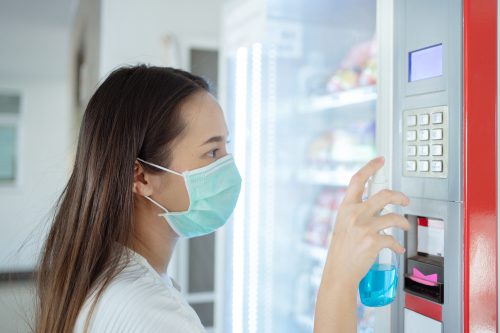
As seen in Vending Market Watch
We talked with Greg Sidwell, president of G&J Marketing and Sales and NAMA board chair, about how his company is responding to the coronavirus pandemic. Sidwell offers actionable advice for operators and insight into how our industry can prepare for a brighter future.
Q: What are operators telling you about doing business during the coronavirus crisis?
A: It’s a mixed bag, but the reality is that the industry is down, anywhere from 50 to 60%, depending on who you talk to. That’s a big downturn, and we’ve got to take that seriously. But we’ve had recessions and different natural disasters and things that made business look bleak, and it’s like I’ve always said: There were millionaires and billionaires made during the depressions of the past. So, no matter what’s going on with the economy, there are always opportunities for those who are looking for the opportunities and know how to seize the opportunities.
Q: How has G&J responded to this crisis?
A: We got involved almost immediately with finding, sourcing and selling PPE [personal protective equipment] products. And that’s helped tremendously because food sales are down, and there’s nothing I can do about that. But I’m listening to what people need for their employees and what the accounts they serve need for their employees. So, we started sourcing sanitizers and all kinds of masks. And that’s been a big help to us and our customers, and our customers’ customers. That’s one of the things we did early on to help get in front of it.
We’ve had a lot of operators who were reaching out to school systems and hospitals that needed emergency meal kits. We’ve been able to source a tremendous amount of shelf-stable items that would work with these emergency meal kits, and we got that information back to the operators who contacted us. We’ve even reached out to other operators, recommending that this is something they should be looking at in their areas.
Q: What has NAMA done to help inform operators on how to navigate this crisis?
A: The work that NAMA has done — holding town hall calls, answering questions from operators — I think that’s been very positive and helpful. The biggest thing I see out of this, and any disaster, is the spirit that comes out of everyone. What everyone is trying to do now is work together and help each other. People that in the past were competitors and maybe not so willing to share information, I now see them working with each other and trying to figure out ways to help each other’s business. It’s all about survival, and everybody recognizes that we’re all in this together. No one person is going to come out of it — we’re all going to come out of it. So, seeing that spirit come out of people, that willingness to collaborate and care for each other and help each other, that has been very positive.
Q: What do you see happening after we emerge from the coronavirus pandemic and attempt to get back to business as usual?
A: It’s hard right now — I can’t see the future, just like nobody else can — but I don’t believe that things will ever go back 100% the way they were. This will cause a shift in the consumer psyche in the way that we think about work and what we do. I think it will change the workplace.
I don’t know exactly what the convenience services industry will look like when we get on the other side of this. There’s no doubt in my mind that we’ll get on the other side of this, but the landscape is going to look different and the industry will probably operate differently. But from that, there’s also a lot of excitement because change is always exciting.
I think the worst thing any of us can do is get paralyzed from the uncertainty and the fear of what’s going to happen and do nothing. We’ve got to look for those opportunities, and we’ve got to keep a positive outlook. We will get through this. The world is not going to end because of this. If we’re positive, and we keep our workforce positive, and we’re looking for those changes, we can figure out what the new needs are. When people come back to work, what’s going to change about the work environment? What are the new needs and the new opportunities for us to get involved in?
For example, Panera Bread is getting into the pantry business. Is there an opportunity for the convenience services industry to work with Panera Bread and allow them to offer a full pantry menu? If we stay focused and we help each other, we’ll find how to work these opportunities into what we do in the convenience services industry and continue to grow. I’m excited to jump in with the operators, the distributors, the manufacturers, with everybody and find out what we need to do to stay strong and keep moving forward.
Q: How would you recommend that operators could identify these opportunities and plan for the future?
A: Talk to your locations, both the ones that are still open and the ones that have had to close. Every business has been affected in some way. For example, for grocery stores, established online suppliers, wholesale clubs, and home improvement, this has all been very positive for business. Talk to those people about what’s changed and what they see changing long term, because they’re having to think about their business differently as it goes forward.
And then the reverse is talking to the ones who’ve had to close their business temporarily. What are they anticipating? What are they working on? Even though the business is closed, the management is still there and anxious to reopen that business. They have thoughts about what their needs are and what they’ll need service people to do for them so they can stay open.
So, reaching out and having those conversations is key. And, reaching out to other operators and asking what they’re seeing and how this has changed their business. Some are more fortunate than others, if they’ve had Amazon distribution centers, or Costco or Sam’s Club or Walmart distribution centers, or any of the big grocery store chains, hospitals and businesses that have been working overtime. It doesn’t necessarily offset what they’ve lost on the other side, but they’re seeing both dynamics. Right now, talk to your accounts, other operators, your brokers and your distributors to learn where they’re seeing successes.
To read the rest of the article, click here.

